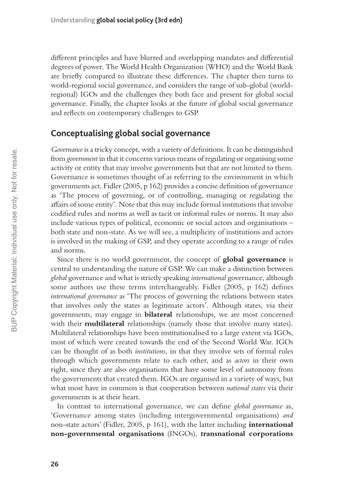Understanding global social policy (3rd edn)
different principles and have blurred and overlapping mandates and differential degrees of power. The World Health Organization (WHO) and the World Bank are briefly compared to illustrate these differences. The chapter then turns to world-regional social governance, and considers the range of sub-global (worldregional) IGOs and the challenges they both face and present for global social governance. Finally, the chapter looks at the future of global social governance and reflects on contemporary challenges to GSP.
BUP Copyright Material: Individual use only. Not for resale.
Conceptualising global social governance Governance is a tricky concept, with a variety of definitions. It can be distinguished from government in that it concerns various means of regulating or organising some activity or entity that may involve governments but that are not limited to them. Governance is sometimes thought of as referring to the environment in which governments act. Fidler (2005, p 162) provides a concise definition of governance as ‘The process of governing, or of controlling, managing or regulating the affairs of some entity’. Note that this may include formal institutions that involve codified rules and norms as well as tacit or informal rules or norms. It may also include various types of political, economic or social actors and organisations – both state and non-state. As we will see, a multiplicity of institutions and actors is involved in the making of GSP, and they operate according to a range of rules and norms. Since there is no world government, the concept of global governance is central to understanding the nature of GSP. We can make a distinction between global governance and what is strictly speaking international governance, although some authors use these terms interchangeably. Fidler (2005, p 162) defines international governance as ‘The process of governing the relations between states that involves only the states as legitimate actors’. Although states, via their governments, may engage in bilateral relationships, we are most concerned with their multilateral relationships (namely those that involve many states). Multilateral relationships have been institutionalised to a large extent via IGOs, most of which were created towards the end of the Second World War. IGOs can be thought of as both institutions, in that they involve sets of formal rules through which governments relate to each other, and as actors in their own right, since they are also organisations that have some level of autonomy from the governments that created them. IGOs are organised in a variety of ways, but what most have in common is that cooperation between national states via their governments is at their heart. In contrast to international governance, we can define global governance as, ‘Governance among states (including intergovernmental organisations) and non‑state actors’ (Fidler, 2005, p 161), with the latter including international non-governmental organisations (INGOs), transnational corporations
26

